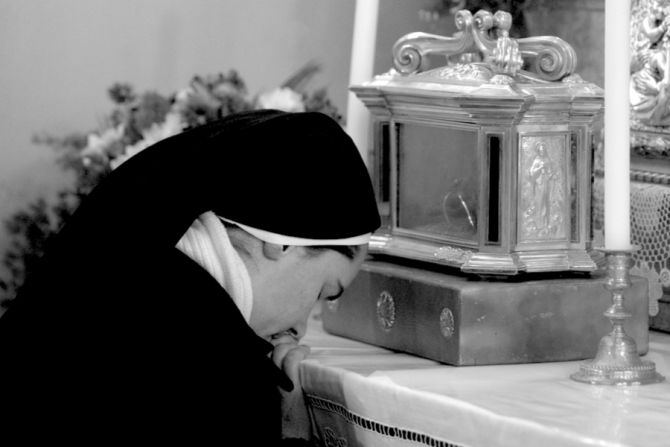"We adore Christ, because He is the Son of God, but the martyrs we love as disciples and imitators of the Lord. So we buried in a becoming place Polycarp's remains, which are more precious to us than the costliest diamonds, and which we esteem more highly than gold." (Acts of St. Polycarp, composed approx. 156 AD)
Polycarp was a significant figure. He was converted by John the Apostle, who had baptized him and subsequently ordained him a bishop. Thus we see that from its outset the Church practiced devotion to the remains of the martyrs.
What is the spiritual significance of relics?
I think that St. Jerome put it best when he said:
"We do not worship relics, we do not adore them, for fear that we should bow down to the creature rather than to the creator. But we venerate the relics of the martyrs in order the better to adore him whose martyrs they are." (Ad Riparium, i, P.L., XXII, 907).
We venerate relics only for the sake of worshiping God.
When we collect relics from the body of a saint, what part of the body do we use?
Any part of the saint's body is sacred and can be placed in a reliquary. Any and every bone may be used. In addition, flesh, hair, and sometimes blood, are also used. Sometimes everything from the tomb is dispersed from it. Sometimes a tomb is preserved.
At what point in the canonization process are items or body parts considered official relics by the Church?
Before the beatification takes place, there is a formal rite whereby the relics are identified and moved (the official word is "translated") into a church, a chapel, or an oratory. Put simply, the grave is exhumed and the mortal remains are retrieved.
Only the Church has the juridical power to formally recognize the sanctity of an individual. When the Church does this – through beatification and canonization – their relics receive the canonical recognition as being sacred relics.
There is an importance difference between beatification and canonization. Beatification is the declaration by the Church that there is strong evidence that the person in question is among the blessed in heaven. Nevertheless, beatification permits only local devotion. That is, devotion in the country in which the individual lived and died. When Mother Teresa was beatified, for instance, only in India and in her native Albania was her devotion permitted. Her Mass could not be celebrated, for example, in the United States, nor could her relics be placed within its altars.
Whereas beatification permits local devotion, canonization, on the other hand, mandates universal devotion. It grants to the canonized individual the rights of devotion throughout the universal Church.
The Church allows saints' body parts to be scattered for relics, but forbids the scattering of ashes of the deceased who are cremated. Why is that?
Every person has a right to a burial. This means that the community has a duty to bury the dead.
Every human society and culture throughout time has felt this duty. The dead have always been buried, and archaeology has never discovered a human community that did not practice this. One could rightly say, therefore, that burying the dead forms part of our human cultural DNA.
The theological term for this instinct is natural law. Nature has imprinted a law within the human heart that manifests itself in the practice of burying the dead as a final act of love and devotion, or at least an act of respect and propriety.
It should be no surprise, then, that the Church lists as one of the corporal works of mercy burying the dead. Grace does not destroy nature but perfects it.
There is flexibility in the kind of burial. Remains may be buried in the ground, in the sea, or above ground within, for example, a cave or columbarium. The point is that a burial occurs within a single place, such that it can be said that the person "occupies" the place as a final location of rest. The human heart longs for this. We see people arriving at graves and speaking to the grave as if they were speaking to the deceased. And they do so differently than they might speak to the dead at home. At the grave, they speak to the dead as if they are in a place.
For this reason, among others, the Church has always taught not only that it is completely beneath the dignity of human body to have its remains "scattered," but also completely beneath basic human sensibilities. People need a place to encounter and meet the dead in their physicality.
Nevertheless, the saints, as members of the body of Christ, have a right to have their remains venerated. And this right, flowing from their dignity as members of the Body of Christ, supersedes their right to have their remains remain in burial.
What is the proper way to keep relics? Are lay Catholics allowed to have first class relics in their homes?
Relics are very precious. They are not something that was alive at one time and is now dead. In the case of first class relics, we are talking about flesh that is awaiting the general resurrection, where the soul of a saint will be reunited with his physical remains.
As such, the way we treat relics is of the utmost importance. Ideally, relics should be kept in a Church or chapel where they can be made available for public veneration.
The highest honor the Church can give to a relic is to place it within an altar, where the Mass may be celebrated over it. This practice dates from the earliest centuries of the Church. In fact, the sepulchers of the martyrs were the most prized altars for the liturgy.
As an alternative to encasing them within altars, they may be installed within a devotional niche where people may venerate them. Such shrines are important as they afford people a deeper experience of intimacy with the saint.
The Church does not forbid the possession of relics by lay persons. They may even keep them in their homes. However, because of the many abuses that have been committed concerning relics, the Church will no longer issue relics to individuals – not even to clergy.
These abuses included failing to give them proper devotion (neglect), careless mistreatment of them, discarding them, and in some cases, even selling them. The abuses were not necessarily committed by the person to whom the Church had originally bequeathed the relics. But when such persons became deceased, and the relics were passed on by inheritance, they were often subject to great vulnerability. With the eclipse of the Christian culture in the western world, faith can no longer be taken for granted, even among the children of the most devout people.
Thus, to protect relics, the Church only issues them to Churches, chapels, and oratories.
How important is the authenticity of the relic? How does the Church go about determining authenticity of very old relics from the beginning of the Church?
The authenticity is critically important.
But for the ancient saints, determining identity is much easier than you might think. It was tradition to build a church over top of a saint's grave. That is why St. Peter's Basilica is where it is, or why St. Paul Outside the Walls is there. Both encompass the tomb for the saint, which is located directly beneath the altar.
Modern archaeology has only affirmed what the ancient tradition has believed.
...
This article was originally published on CNA Aug. 11, 2017.
Mary Farrow worked as a staff writer for Catholic News Agency until 2020. She has a degree in journalism and English education from the University of Nebraska-Lincoln.




